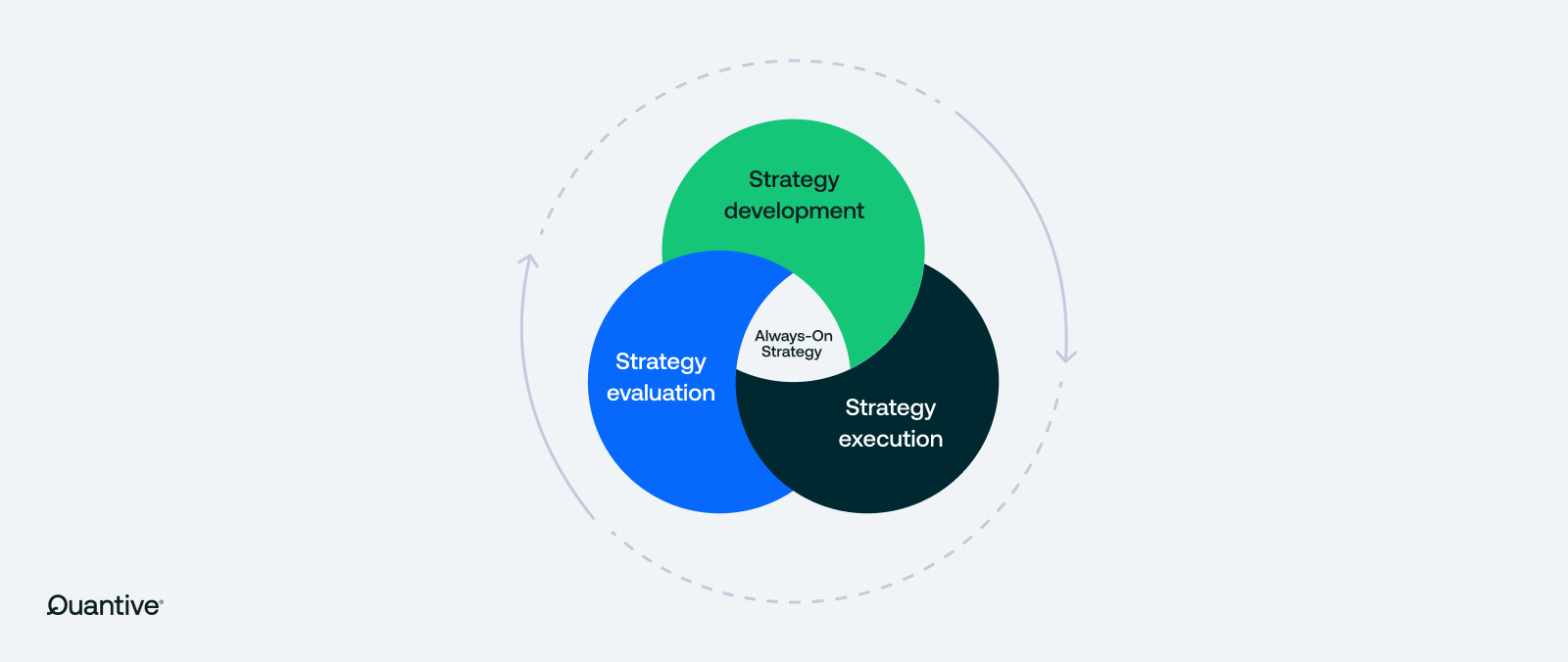Quantive is now part of WorkBoard. Get to know WorkBoard:
The days of set-and-forget strategy are gone. Sticking to a devised strategy no matter what happens in the market is akin to dressing for the weather based on last week’s newspaper. You can’t rely on yesterday’s news, both in your personal life and in your organization.
Enter dynamic strategy — your opportunity not just to stay afloat in the shifting tides of today’s business environment but to navigate with confidence despite its unpredictability. In simple terms, dynamic strategy is the ability to continuously evolve your plan to respond to internal and external change
According to the Global State of Strategy Guide, most (90%) organizations struggle to adapt to market changes, with only 10% of leaders in those organizations believing their business can pivot quickly and effectively.
Dynamic strategy is the answer to this modern decision-making problem.
What is dynamic strategy?
Traditional static strategies are often rigid and slow to adapt, while a dynamic strategy is flexible, proactive, and always evolving. Dynamic strategy works with real-time data, continuous monitoring, and quick decision-making.
A dynamic business strategy empowers your business to pivot in response to market shifts or unexpected changes in your organization. In essence, dynamic strategy is about making the most informed decision possible at any given moment, adjusting the path forward to get the best outcomes, and following it through; thus finding opportunity in agility.
Core principles of dynamic strategy
To successfully implement a dynamic business strategy, both operational and cultural changes must happen. By nature, a dynamic approach versus one guided by pre-defined cycles introduces elements of friction like speed and uncertainty. Embracing the core principles of dynamic strategy will reduce that friction and set your organization up for success:
Adaptability
The cornerstone of dynamic strategy is the ability to adjust the course quickly without derailing the entire business. This means having flexible processes, agile teams, and a culture that embraces change rather than pushes back against it — to continuously grow is to continuously adapt.
Continuous monitoring and adjustments
Strategy itself isn’t the only dynamic element in dynamic strategy — monitoring is not a periodic or one-off activity, but a continuous practice. You don’t just need a finger on the pulse of both the market and your internal operations, you need to be able to act on it. At Quantive, we believe in the Always-On Strategy model — where strategy development, strategy execution, and strategy evaluation are in a rapid loop of continuous adaptation.

Data-driven decision-making
Dynamic strategy isn’t grounded in intuition, but data. The decisions you make must be based on accurate, up-to-date information turned into relevant insight — not a fleeting instinct at a unique moment in time. This requires leveraging real-time analytics and AI to turn data into insight, thus ensuring that your team is equipped to interpret and act on those insights swiftly.
Step-by-step guide to implementing a dynamic strategy
Bringing about change in your business so that you can operate a dynamic strategy in your business may seem challenging, but there are simple, manageable steps you can take to get there:
1. Conduct regular marketing and business analysis
2. Leverage real-time data and analytics
3. Set clear business objectives
4. Build a responsive planning framework
5. Implement feedback loops
Here's how to get started:
Step 1: Conduct regular marketing and business analysis
A dynamic strategy requires an omniscient perspective, bringing a deep understanding of the external market and your internal business environment. This is achieved through conducting market analyses using tools like SWOT or PESTLE along with competitive analysis.
Internally, you should schedule ongoing business analysis sessions to evaluate the health of your organization, relative to your goal and metric progress. The insights gained from these analyses will help you identify opportunities for growth and resource re-alignment.
Getting through the learning curve for this ongoing analysis takes time, plus plenty of trial and error. Using a Strategic Intelligence Platform like Quantive StrategyAI can accelerate this learning curve, providing you with the real-time data, insights, and support you need for your internal business analysis.
Learn how a Strategic Intelligence Platform helps your business analysis.
Step 2: Leverage real-time data and analytics
Data isn’t your most valuable asset — how you equip your team to use it is. To leverage this asset and make informed decisions, you need access to real-time data and analytics. Having the right tools and technologies provides updated information about market trends, customer behavior, and key performance metrics.
Automation is essential here — data collection alone could require a full-time employee if conducted manually. By automating real-time data collection and analysis, you can free up your team's time to focus on interpreting the data and making quick decisions. Strategic Intelligence Platforms (like Quantive StrategyAI) can enhance this focus, offering integrated data capabilities to help your teams connect, correlate, and interpret data in strategic decision-making.
Step 3: Set clear business objectives
The next step is to identify key business goals and set clear, measurable objectives. These goals should be concise and captivating yet quantifiable and with a specific result, measurable, achievable, relevant, and time-bound (SMART).
With a dynamic business strategy, finding a balance between short-term flexibility and long-term vision is critical. Your short-term goals are oriented more around the “how” — they should be adaptable, allowing quick pivots in response to changing circumstances. Your long-term goals are more rooted in your company's mission and vision (the “why”), providing direction even as the details may and will evolve.
While long-term goals give you a finish line to work toward, while short-term goals offer different paths to get there (which can change). Lean too much on your long-term goals and your strategy becomes rigid — lean too much on your short-term goals and your operational wheels will keep spinning. Finding balance in your objectives is critical. This balance is supported by a responsive planning framework.
Step 4: Build a responsive planning framework
A dynamic strategy requires a planning framework that is both structured and flexible. Your strategic plans should be well-defined, but they should also allow for adjustments based on new information or changes in the market.
One effective approach is to build regular evaluation points where you can assess the effectiveness of your strategy execution and feed evaluation insights back into both execution and the strategic plan itself. This feedback loop ensures that your strategy remains relevant and effective over time.
Quantive StrategyAI's adaptability makes it an ideal tool for building and maintaining a responsive planning framework.
Step 5: Implement feedback loops
Feedback loops are both the end and the beginning of a dynamic strategy. By establishing a frequent review cadence, you can assess your progress, gather feedback from your team, and make necessary adjustments to your strategy.
Whether grounded in OKRs, a Balanced Scorecard, or other progress frameworks, these reviews should focus on goal progress, roadblocks, and in-the-trenches insights on how execution is going. From there, key feedback points can be extracted, brought into the strategic planning process, and reported on in future reviews.
Feedback loops allow you to identify what's working, what needs improvement, and where new opportunities may be emerging. Quantive StrategyAI supports this with a platform for Always-On Strategy, improving your business reviews and check-ins to:
- Identify risks and eliminate blockers
- Streamline meetings and share progress
- Make informed adjustments with AI-driven suggestions
An illustration of dynamic strategy in action
One of the best ways to understand the power of dynamic strategy is to apply it through a real-world lens. Let’s imagine a company called PedalTone, a global leader in the fitness industry technology, as an example.
Faced with the challenges of going from a pre-COVID market, booming in the COVID shift, and the post-COVID correction, PedalTone knew all about the challenges of a rapidly changing market. This would make them the perfect candidate for dynamic strategy.
PedalTone could use Quantive and StrategyAI to develop a dynamic strategy and adapt their offerings. Rather than stall on strategic decision making while competitors shifted to service at-home and in-the-gym markets, PedalTone could move swiftly based on real-time data.
Quantive Strategy AI can generate a decision map based on market potential, competition, customer considerations, GTM strategy, and financial projections. In minutes — not days, weeks, or even months — PedalTone’s leadership would have a SWOT analysis ready for strategic response.
By leveraging dynamic strategy through Quantive, PedalTone could pivot quickly in response to new trends, launching initiatives around mid-level gym partnerships, AI-driven customer retention, and a new product line. This example is a testament to the power of dynamic strategy in driving business growth.
Best practices for creating a dynamic strategy
Implementing a dynamic strategy requires more than just following a set of steps. It also involves fostering a culture and environment that supports continuous adaptation and innovation. Here are some best practices to consider:
Nurture a culture of continuous learning and innovation
A dynamic strategy can thrive if learning and innovation make up the fabric of your team. Push your team to seek out new knowledge, create an environment for experimentation, and encourage both successes and failures as learning opportunities. A learning culture can be achieved through training sessions, workshops, and strategic management team that celebrates creativity and risk-taking.
Enhance cross-functional collaboration
Dynamic strategy is not the responsibility of a single department — it's a company-wide effort at strategic thinking. When different teams work together to share insights, align on goals, and drive strategic initiatives forward, it creates a clearer picture of the organization’s strategy.
This can be achieved by creating cross-functional teams for strategic projects, holding regular inter-departmental meetings, and using collaborative tools for communication and information sharing across the organization.
Embrace data and AI
Having the data is one thing — training your team to understand and act on the insights gained from this data is another. Having your teams embrace a data-driven approach may take enablement sessions, where data-focused leaders and team members share strategies and guidance for incorporating strategy dynamics data into the business-as-usual functions.
AI can play a critical role in empowering your leadership teams with the insights they need from the vast amounts of data at their disposal. The combination of data connectivity and AI can help everyone in your organization, regardless of skill level, embrace a data-driven approach.
Moving from what a team “wants” to do (informed by intuition) to what a team “should” do (informed by data and system dynamics) takes a cultural shift as much as an operational one. Don’t neglect the mental adjustment this can take, especially for teams most distanced from the data. It can be the key factor to improve performance across your organization.
Conclusion
The days of relying on a strategy you set 90 days or 6 months ago are gone. A static strategy is no longer enough. To stay competitive, your business must embrace a dynamic approach to strategy — one that is flexible, data-driven, and continuously evolving.
By following the steps outlined in this article and adopting the best practices highlighted, you can implement a dynamic and competitive strategy that not only responds to change but anticipates it and makes it a competitive advantage.
Your business environment never stands still, and your strategy shouldn't either. So, embracing a dynamic approach to strategy is an ongoing commitment. It’s always on. It permeates your entire organization. By leveraging solutions like Quantive StrategyAI, you can effectively drive agility, responsiveness, and composure under adaptation, no matter what “dynamic” means for your business.
Quantive empowers modern organizations to turn their ambitions into reality through strategic agility. It's where strategy, teams, and data come together to drive effective decision-making, streamline execution, and maximize performance.
As your company navigates today’s competitive landscape, you need an Always-On Strategy to continuously bridge the gap between current and desired business outcomes. Quantive brings together the technology, expertise, and passion to transform your strategy and playbooks from a static formulation to a feedback-driven engine for growth.
Whether you’re a fast-growing scale-up, a mid-market business looking to conquer, or a large enterprise looking for innovation, Quantive keeps you ahead – every step of the way. For more information, visit www.quantive.com.





